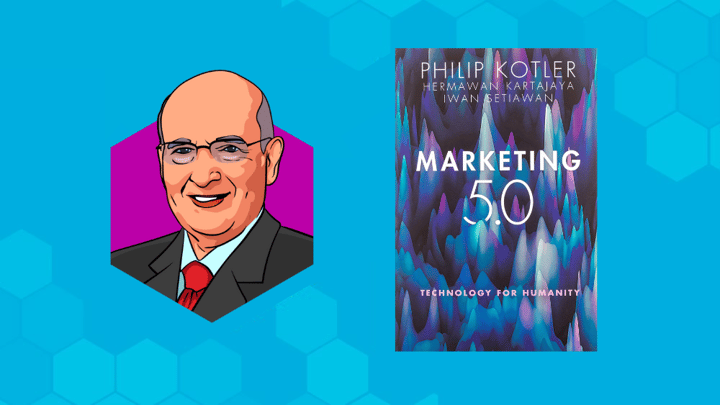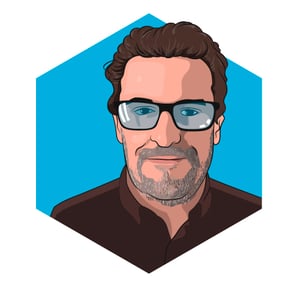We're bringing you the best insights written in the world of marketing today, thanks to our sponsors at Integrate!
“Every company needs two marketing departments, one that has mastered the tactics of getting rid of today’s products and the other that has mastered the strategy of imagining tomorrow’s products," Philip Kotler has said.
With the importance placed on technology, and how it can transform a business, in Marketing 5.0, it is no surprise he and his co-authors are promoting tech as an element of an ultra-smart society.

In Marketing 5.0 Philip Kotler, Hermawan Kartajaya, and Iwan Setiawan explain how marketers can utilise technology to tackle customer needs and make a tangible social difference in the world.
This book is timely, coming within a new age where marketers are attempting a digital transformation of businesses, as well as changing customer behaviour. So, Marketing 5.0 offers a way for marketers to integrate technological and business model evolution with these shifting consumer patterns.
The term Marketing 5.0 is inspired by the idea of 'Society 5.0', Japan's blueprint for a modern, tech-driven society. Hermanwan Kartajaya stated:
"We feel it is time for companies to unleash the full power of advanced technologies in their marketing strategies, tactics, and operations. This book is partly inspired by Society 5.0—a high-level initiative of Japan—which contains a roadmap to create a sustainable society supported by smart technologies.
Technology can and must be leveraged for the good of humanity. Marketing 5.0, by definition, is the application of human-mimicking technologies to create, communicate, deliver, and enhance value across the customer journey."
A major part of this is the promotion of 'next tech', which will, and do, aid modern marketers in their quest for tech-driven marketing excellence. Kartajaya continues:
"One of the critical themes in Marketing 5.0 is what we call the next tech, which is a group of technologies that aim to emulate the capabilities of human marketers. It includes AI, NLP, sensors, robotics, augmented reality (AR), virtual reality (VR), IoT, and blockchain. A combination of these technologies is the enabler of Marketing 5.0."
Want more information on the growth of NextTech, the markets which surround it, and what tech you need in your marketing? Well then, subscribe to our NextTech newsletter, right here.
Why Marketing 5.0 is Vital for Any Modern Marketer
"The book is timely and has great relevance at the present COVID-19 time. The continued lockdown in many countries has forced companies to look at the digital aspects of marketing. It is also the right size to be a handbook for practising managers," reviews Walter Viera, Former Chairman, International Council of Management Consulting Institutes.
Marketing 5.0 clearly outlines the way in which marketers can face a number of major movements, such as dramatic technological advances, changing customer behaviour, and shifts in business models.
So, using practical and accessible details, the book outlines how these three changes require marketers and companies alike to adapt, especially when it comes to technology. The work's idea of "Technology for Humanity" is the cumulation of this, being a way to find approaches to tech which advance customers' non-material needs.
The book begins with an analysis of how generational changes have created a new form of customer behaviour. It offers a solution on how to overcome the differences that divide the global population, such as political disagreements and economic equality so you can reach these divided groups as a whole.
Part two moves on to the new strategic directions being taken by businesses around the world, and proposes ways to address the new business models which define the modern environment.
The third part explores the reality of rapid technological advancements in fields such as AI, the ubiquity of sensors, augments and virtual reality, and the internet of things.
About the Authors
Philip Kotler: Philip Kotler is Professor Emeritus of Marketing at the Kellogg School of Management, where he has held the S.C. Johnson & Son Professorship of International Marketing. Philip has taught at this school for more than 50 years. He is known around the world as the "father of modern marketing", and his books have been translated into more than 25 languages.
He has received honorary degrees from 22 universities including Stockholm University, the University of Zurich, Athens University of Economics and Business, Budapest School of Economics and Administrative Science, the Kracow School of Business and Economics, and DePaul University.
Hermanwan Kartajaya: Hermanwan is the founder and Executive Chairman of MarkPlus Inc, and the recipient of the Distinguished Global Leadership Award from the Pan-Pacific Business Association at the University of Nebraska-Lincoln. He was named one of the "50 Gurus Who Have Shaped the Future of Marketing" by the Chartered Institute of Marketing in the United Kingdom. He is also the Chairman of the Asia Council for Small Business and a co-founder of the Asia Marketing Federation.
Iwan Setiawan: Iwan is the Chief Executive Officer of MarkPlus Inc., where he helps businesses design their corporate and marketing strategies. A prolific writer and speaker, Iwan is also the Editor-in-Chief of Marketeers.
Top Takeaways
Number One: Marketing 5.0 and the Generation Gap
The book aims, with the idea of Marketing 5.0, to show where marketing has been, where it is now, and where it will go. Previously, the authors have described several approaches in marketing. These are:
- Marketing 1.0. This is product-centric marketing.
- Marketing 2.0. This is consumer-oriented marketing.
- Marketing 3.0. This is values-driven marketing. The main focus in the person, moving from a consumer orientation to a person orientation. It means a pursuit of profit is combined with corporate responsibility. It is designed to meet the needs of the consumer, but companies use this marketing to promote a mission, vision, and values.
- Marketing 4.0. This represents a move from traditional marketing, to digital. IT combines online and offline interaction between companies and consumers.
- Marketing 5.0. This is the application of human-mimicking tech to create, communicate, deliver and enhance value across the customer journey. It combines elements of the two previous approaches: Marketing 30 with a human orientation, and Marketing 4.0 with a tech focus.
Marketing 5.0 is also centred around three interrelated applications: predictive marketing, contextual marketing, and augmented marketing.
The authors also provide the background behind the need for marketing 5.0, outlining the three big challenges facing marketers today:
Marketing 5.0 materialises against the backdrop of three major challenges: generation gap, prosperity polarisation, and the digital divide. It is the first time in history that five generations living together on Earth have contrasting attitudes, preferences, and behaviours.
The Baby Boomers and Generation X still hold most of the leadership positions in businesses and the highest relative buying power. But the digital-savvy Generations Y and Z now form the largest workforce as well as the biggest consumer markets. The disconnect between the older corporate executives who make most decisions and their younger managers and customers will prove to be a significant stumbling block.
- Iwan Setiawan
Number Two: The Five Ways to Boost Marketing Practises
- More informed decisions based on big data. The biggest side effect of digitisation is big data. Every interaction and touchpoint is recorded. This means there are plenty of insights to extract, allowing marketers to access a rich source of information. As a result, marketers can profile customers at a granular and individual level.
- Predicted outcomes of marketing strategies and tactics. "No marketing investment is a sure bet," says Iwan Setiawan. Calculating the return on every marketing action makes marketing more accountable. This is made much easier with AI, so marketers to predict the outcome before trying new campaigns. The predictive model also aims to discover patterns from previous campaigns, so marketers can stay ahead of the curve.
- Contextual digital experience in the physical world. The tracking of users enables marketers to provide highly contextual experiences.
- Frontline marketer's capacity to deliver value is augmented. Marketers can focus on building an optimised symbiosis between themselves and digital technologies: from chatbots to AR and VR, to AI and NLP. So, frontline marketers can concentrate on delivering highly coveted social interactions only when they need to.
- Accelerated marketing execution. Technology speeds up marketing execution. Customers are now preferring speed, being 'always-on'. This puts pressure on businesses to profit from a shorter window of opportunity. So, companies can begin to draw inspiration from the agile practices of lean start-ups. They rely heavily on technology to perform rapid market experiments with real-time feedback. So, it's all about the right agile attitude on top of the backing of technology.
Number Three: The Polarisation of Society
The polarization of society due to wealth disparity has an impact on many parts of human lives. This adds to political uncertainty, social instability, and economic collapse.
The markets expect companies to be the ones to fix this with a more inclusive and sustainable approach to pursuing growth. Businesses used to believe that if they reinvested their profits for the development of society they did it at the expense of faster growth. But the opposite is true. "Decades of aggressive growth strategies have left the environment degraded and society unequal. Companies cannot thrive in a failing and declining society," says Iwan Setiawan.
Team reviews
 Reviewed by: Graham Charlton, Head of Content at LXA
Reviewed by: Graham Charlton, Head of Content at LXA
Marketing 5.0 is an essential book, with a keen focus on how marketers need to understand new technology - nexttech - and use it to deliver a compelling customer experience. This focus on technology is underpinned by an understanding that the human element in marketing remains the key factor - only humans can understand other humans
Final Thoughts
Marketing 5.0 integrates the major challenges faced by marketers today into one complete, overarching birds-eye view. These are the dramatic technological advances, changes in consumer behaviour, and business model shifts, with the reader being provided with practical guidelines for finding ways to use technology to adapt to these and to advance the consumer's non-material needs.
This book is perfect for traditional and digital marketers, due to its actionable recommendations and unique insights.
It also pushes the point that technology is here to aid, not replace:
"Since we cannot teach computers the things we do not know how to learn, the role of human marketers is still critical in Marketing 5.0. The central discussion in Marketing 5.0, hence, is around selecting where machines and people might fit and deliver the most value across the customer journey"
-Iwan Setiawan
Link to purchase page
Purchase Marketing 5.0 on Amazon or Audible
Other Books You May Be Interested In
- Obviously Awesome - April Dunford
- Hacking Growth -Sean Ellis & Morgan Brown
- Digital Darwinism 2nd ed - Tom Goodwin
We're bringing you the best insights written in the world of marketing today, thanks to our sponsors at Integrate 👇
Stay tuned for more! 📖📚


